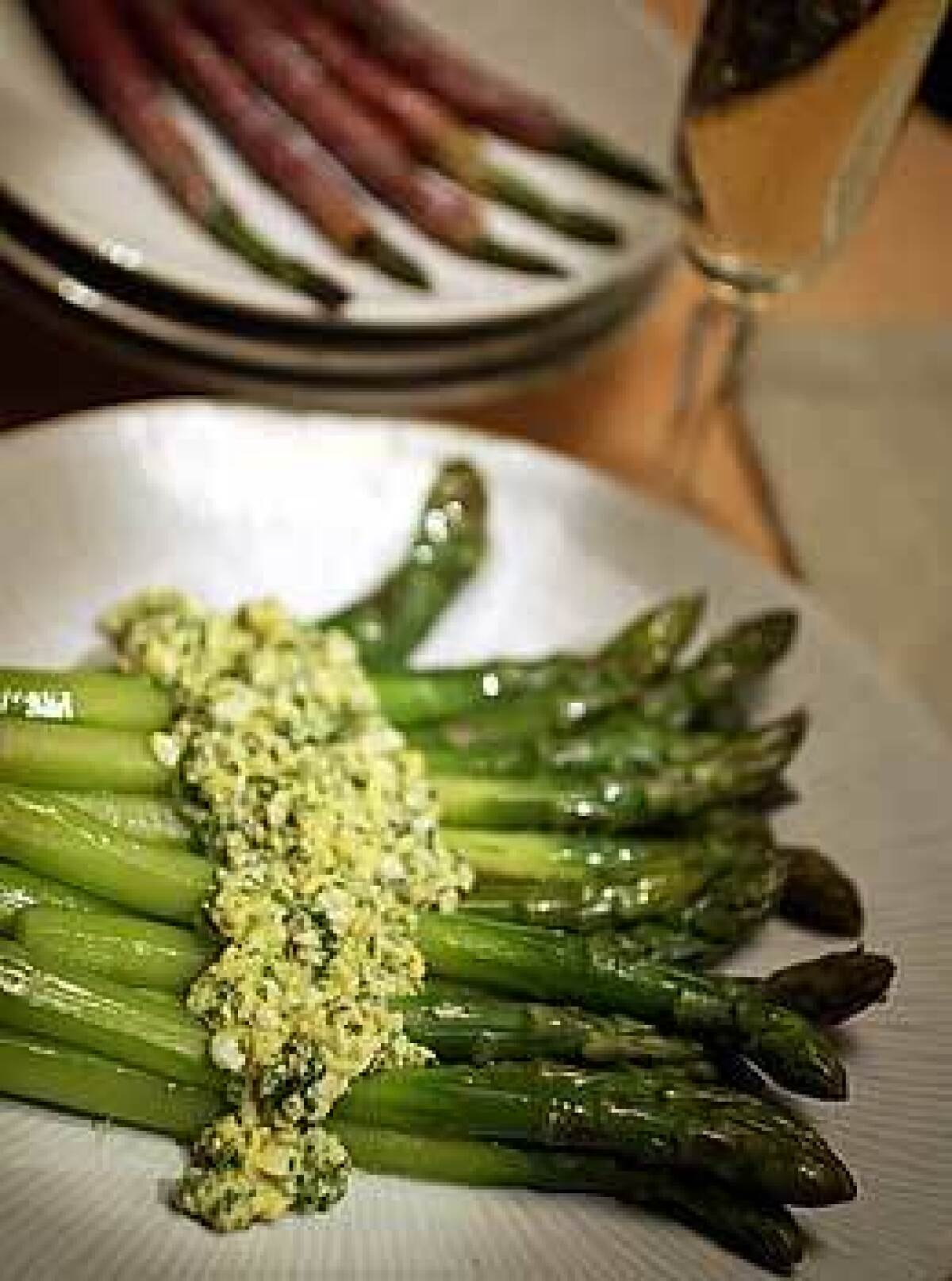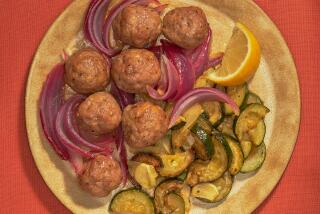The great asparagus divide

- Share via
True lovers of asparagus are a devout bunch, united in their passion for spring’s first green spears and resolute in their refusal to be seduced by the siren song of out-of-season impostors. But within this flock lies a deep division. Meet another asparagus devotee and the first question they will usually ask is: “Thick or thin?”
Spear size, it seems, has become an ideological issue.
Believers in skinny spears claim that theirs is superior because it doesn’t need to be peeled. It is delicate and crisp. Its very slenderness is evidence that it truly is the first spear of spring.
Followers of the fatties respond equally dogmatically. Their spears aren’t tough at all. Further, they are obviously the one true choice because what could better befit the promise of spring than a rich, juicy texture?
I refuse to be drawn into the debate. Preferring to spread olive oil on these troubled waters, I embrace both sides. Skinny and fat, all asparagus spears are good, in their own ways.
Let the healing begin. But before we can move forward, we must dispel some myths.
First, a slender spear is not a sign of the first harvest. In fact, it must be said, the opposite is true. Whether asparagus is thick or thin depends on many things, but primary among them is what farmers call vigor — how healthy the plant is. On this issue, the scientific evidence is clear: Plants just beginning to produce make fatter spears.
It’s not as cut and dried as that, though, because the same plant will produce a range of sizes. Asparagus grows from a mass of roots and each mass sends up scores of spears. Those that come up closest to the center, where the plant stores its nutrients, are fatter. Those farther out on the fringe are thinner.
Furthermore, while fatter asparagus does have a thicker, more fibrous peel that does need to be removed before cooking, it also has much more tender inner flesh. The peel is thinner on slender asparagus, but so is the center.
While we’re dispelling myths and cookbook clichés, let’s also get rid of the whole “snapping off the woody base” thing once and for all. It is true that the lower portion of asparagus is tougher and stringier and that some of it does need to be removed before the spears are cooked.
It is also true that if you follow the conventional wisdom on removing the tough part — hold the tip of the asparagus in one hand and the base in the other and bend the spear until it snaps — you will waste a lot of asparagus. Try it yourself: Snap some asparagus and then cook the supposedly woody end. You’ll find that much of what you would normally discard is edible — even delicious — down to the last inch and a half or so. You’re much better off simply removing that portion with a knife.
With fat asparagus, the peel is thicker and more fibrous toward the bottom. So, start peeling from the tip, using gentle pressure, and then gradually increase the pressure toward the base. This will get rid of all the tough parts and leave only the juicy core. (White asparagus, in particular, tends toward the stringy; in Europe a special peeler is used with an adjustable blade that will trim more deeply than normal.)
On a related plumbing issue: No matter how big a hurry you are in, do not put those asparagus peels down the drain. I don’t care if your garbage disposal will grind glass, it will not break up asparagus peels.
Just because all spears are equally good doesn’t mean that they are equally good for all things. For me, the choice of skinny or fat comes down to whether I’m going to use the asparagus as a vegetable or as an ingredient.
When I’m thinking of a plain platter stacked high with asparagus that has been simply boiled or steamed and lightly dressed with, say, a brightly colored sauce mimosa, the only choice is thick spears. And if it’s the first asparagus of the season, there will likely be enough to make up the whole dinner.
Properly cooked, which is to say long enough that the asparagus is tender all the way through but quickly enough that the flavor and color haven’t begun to fade, fat spears are incomparably rich and juicy. The texture is almost like a vegetable mousse, with just a slight resistance to the tooth.
If I’m planning a dish that will include asparagus along with other ingredients — a risotto or a frittata, for example — I’ll pick the thinnest spears I can find. They’ll combine better with the other elements in the dish, where the thick ones might dominate.
Because it hasn’t been peeled, skinny asparagus also tends to be a little crisper and have a brighter color that stands out better in a mix of ingredients.
Spears that are of average size can be used either way, but I think they’re especially good for roasting. They’re not so thin that they cook through before they brown nor so fat that they never get tender. Wrapping them in prosciutto beforehand lends new meaning to gilding the lily.
No single size has a lock on goodness. To each spear its own preparation. We true believers shouldn’t be wasting our energies on silly internal squabbles. We should save our strength for fighting the out-of-seasoners.
*
Asparagus and shrimp risotto
Total time: 1 hour, 10 minutes
Servings: 4 to 6
Note: For asparagus stock, reserve cooking liquid from other preparations.
3/4pound thin asparagus
1/4pound shell-on shrimp
5 cups water or reserved asparagus stock
3 tablespoons butter, divided
1/2 cup minced onion
1 1/2cups Arborio rice
1/4cup dry white wine
Salt
2 tablespoons grated Parmigiano-Reggiano
2 tablespoons snipped chives
1. Cut off the bottom 1 to 1 1/2 inches of the asparagus spears. Thinly slice the bottoms and add them to a large saucepan along with the trimmings from the minced onion. Shell the shrimp and add the shells to the saucepan. Cover with at least 5 cups of water or asparagus stock and bring to a boil. Reduce to a simmer and cook at least 30 minutes to make a mild stock.
2. Cut away the very tips of the asparagus. Chop the shrimp in one-half-inch pieces and add them to the asparagus tips. Slice the remaining parts of the asparagus in one-fourth-inch rounds.
3. Cook the asparagus rounds, 2 tablespoons butter and the onion in a large skillet over medium heat until the onion softens but does not turn color, about 5 minutes.
4. Add the rice and cook, stirring constantly, until all the kernels are opaque, about 3 minutes. Add the wine and stir until it evaporates. Ladle approximately 1 1/2 cups of the simmering stock through a strainer into the rice and cook, stirring, until it evaporates. When the bottom of the pan is almost dry, add an additional one-half to three-fourths cup and repeat.
5. Keep cooking this way, adding more stock as needed, until the rice begins to swell and become tender. Stir in 1 1/2 teaspoons of salt and the reserved chopped shrimp and asparagus tips, and continue cooking until the rice kernels are swollen and completely tender. Do not cook the mixture dry; the final texture should be somewhat soupy with slightly thickened liquid. This will take about 20 to 25 minutes in all.
6. Remove the skillet from the heat and add the remaining tablespoon of butter, the grated Parmigiano-Reggiano and the snipped chives. Vigorously stir these into the risotto. The liquid will thicken even more. Taste and add more salt if necessary. Spoon into hot shallow bowls and serve immediately.
Each of 6 servings: 267 calories; 7 grams protein; 42 grams carbohydrates; 2 grams fiber; 7 grams fat; 4 grams saturated fat; 39 mg. cholesterol; 62 mg. sodium.
*Asparagus in sauce mimosa
Total time: 20 minutes
Servings: 6 to 8
2 eggs
Salt
2 pounds fat asparagus
2 tablespoons minced parsley
1 tablespoon minced mixed herbs (preferably a mix of chives, tarragon and chervil)
1 tablespoon lemon juice
1 tablespoon sherry vinegar
3 tablespoons olive oil
1. Cover the eggs with cold water in a small saucepan and set over high heat. When the water comes to a rolling boil, turn off the heat and let the eggs sit in the water until they are cool enough for you to handle them.
2. Bring a large pot of water to a boil and add salt to taste. Cut off the bottom 1 to 1 1/2 inches of the asparagus. Peel the asparagus, starting very lightly at the tip and gradually increasing pressure toward the base. Boil the asparagus just until tender enough that a knife slips in easily, 4 to 5 minutes. Remove the asparagus from the boiling water to a pan of ice water to stop the cooking.
3. When almost ready to serve, shell the hard-cooked eggs and separate the whites and the yolks. Chop them separately as fine as possible and then combine them in a mixing bowl (chopping them together smears the yolks). Add the parsley, mixed herbs, lemon juice and vinegar and stir together. Stir in the olive oil. Add one-fourth teaspoon salt, then taste and add more if needed.
4. Pat the asparagus dry and arrange it on a platter. Spoon the dressing over the top in a swatch across the middle of the spears. Serve at room temperature.
Each of 8 servings: 79 calories; 3 grams protein; 3 grams carbohydrates; 1 gram fiber; 6 grams fat; 1 gram saturated fat; 53 mg. cholesterol; 22 mg. sodium.
*
Asparagus wrapped in crisp prosciutto
Total time: 20 minutes
Servings: 4 to 6 appetizer servings
Note: This extremely simple recipe is a combination of two old favorites: basic roast asparagus and steamed asparagus wrapped in prosciutto. The contrast between the soft asparagus and the crisp prosciutto is delicious. Serve this with iced Champagne and plenty of napkins to wipe asparagus juice from your fingers.
1 pound asparagus, medium thickness (about 16 spears)
1/2pound prosciutto, sliced medium-thin, about 16 slices from the smaller end
1 tablespoon olive oil
1. Heat the oven to 450 degrees. Cut off the bottom 1 to 1 1/2 inches of the asparagus spears and, if the spears are thick, peel them. Wrap a slice of prosciutto around each spear spiraling upward, with the fatty stripe of the ham at the bottom so it creates a barber pole effect up the spear.
2. Line a jellyroll pan with aluminum foil and smear it lightly with the olive oil. Arrange the wrapped spears in the pan and place in the oven. After 5 minutes, shake the pan vigorously to turn the spears. Roast another five minutes and shake again. Roast until the asparagus is very tender and the prosciutto is somewhat crisp, about 15 minutes total. Serve immediately.
Each of 6 servings: 110 calories; 11 grams protein; 2 grams carbohydrates; 1 gram fiber; 7 grams fat; 2 grams saturated fat; 34 mg. cholesterol; 731 mg. Sodium
More to Read
Sign up for The Wild
We’ll help you find the best places to hike, bike and run, as well as the perfect silent spots for meditation and yoga.
You may occasionally receive promotional content from the Los Angeles Times.









